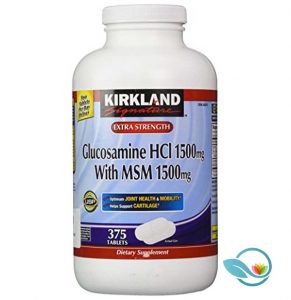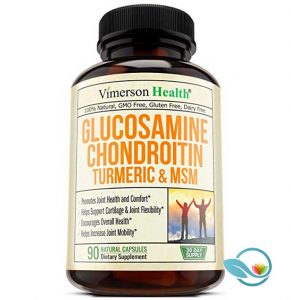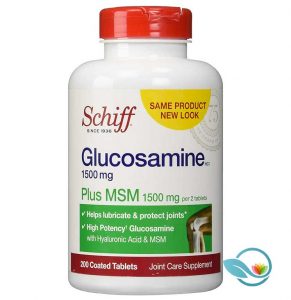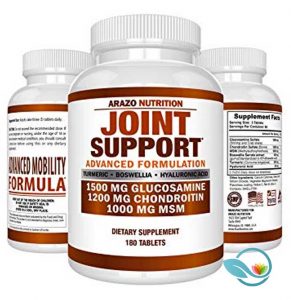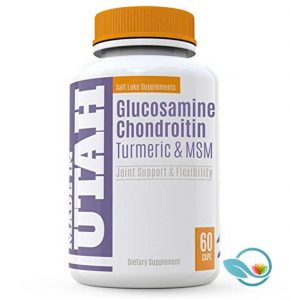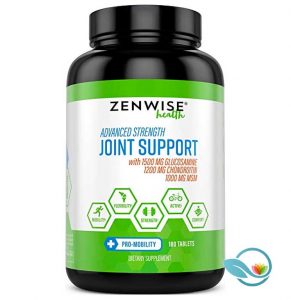Health & Wellness
Best Glucosamine Supplements of 2019
Published
6 years agoon
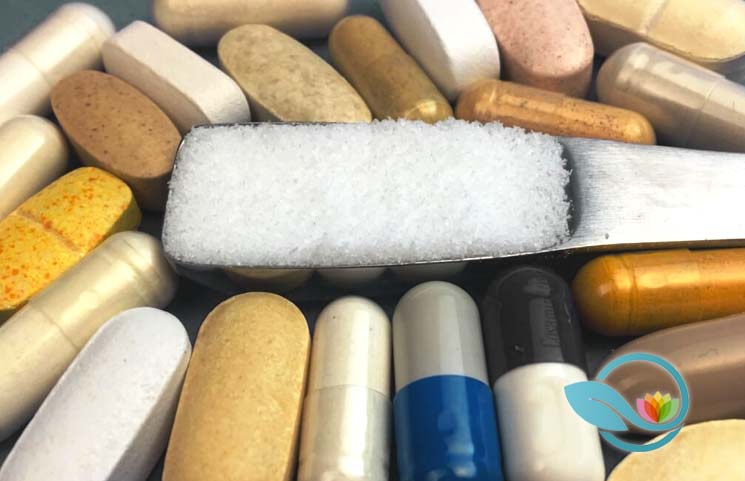
Glucosamine is a popular supplement used to maintain healthy joints. Glucosamine seems to work by reducing the pain and inflammation associated with arthritis in your joints. It may also help to rebuild damaged cartilage and slow the loss of joint space caused by arthritis.
For these reasons and more, many arthritis and joint pain sufferers love taking glucosamine supplements.
Today, most research on glucosamine is related to its treatment of osteoarthritis, the degenerative condition that reduces the cushioning capabilities of the cartilage in your joints.
Glucosamine has proven benefits for reducing joint pain. But which glucosamine supplement is the best one available today? Our editorial team compiled the rankings below to help you pick the best glucosamine supplement of 2019.
Rankings
Kirkland Signature Glucosamine with MSM
Kirkland Signature Glucosamine with MSM is one of the best-value glucosamine supplements available today. Like other Kirkland Signature products, this glucosamine supplement provides a hefty dose of glucosamine and MSM without breaking the bank.
Each tablet of Kirkland Signature Glucosamine with MSM provides 750mg of glucosamine and 750mg of MSM. A single bottle of the formula contains 375 (!) tablets.
Here’s the best part: you don’t have to be a Costco member to buy Kirkland Signature Glucosamine. It’s widely available on Amazon, where the supplement has an average rating of 4.5 stars out of 5 with over 1,600 customer reviews.
Kirkland Signature Glucosamine with MSM, like other glucosamine supplements on this list, claims to provide two primary benefits: it cushions joints and supports movement; and it also helps promote healthy cartilage. All you need to do is take two tablets per day.
Vimerson Health Glucosamine with Chondroitin Turmeric MSM Boswellia
Vimerson Health’s Glucosamine supplement is an “Amazon’s Choice” product when you search for “arthritis”. With 2,500+ customer reviews and an average rating of 4.4 stars out of 5, it’s also one of the best-rated glucosamine supplements available today.
Part of the popularity of this supplement comes from the fact that a number of different trendy ingredients are packaged into one convenient supplement. You not only get glucosamine and MSM, for example, but you also get chondroitin and turmeric. These ingredients are proven antioxidants and anti-inflammatories that may be able to significantly reduce joint pain.
Like the Kirkland Signature supplement at the top of our list, Vimerson Health’s supplement promises to promote joint health and comfort, support cartilage and joint flexibility, encourage overall health, and increase joint mobility. It’s priced slightly higher than the Kirkland Signature glucosamine supplement, at around $27 for 90 capsules (30 servings). It also has a much lower dose of MSM (25mg per 3 capsules). However, the glucosamine dosage is in line with other supplements (1500mg per 3 capsules).
Schiff Glucosamine
Schiff Glucosamine contains 1500mg of glucosamine in each serving along with 3.3mg of hyaluronic acid. Some glucosamine supplements contain hyaluronic acid because it’s believed to help with the cartilage regeneration properties of glucosamine.
Another thing that makes Schiff Glucosamine one of the most popular glucosamine supplements on Amazon and other retailers is the price: you’ll pay just $9 for 150 tablets (50 servings). Each 3 tablet serving includes 1500mg of glucosamine, 1500mg of MSM, and 3.3mg of hyaluronic acid. The dosage is similar to the Kirkland Signature supplement, but with the added benefit of hyaluronic acid.
With over 1,400 reviews on Amazon, Schiff Glucosamine has an average rating of 4.5 stars out of 5, making it another popular, well-rated, and best-selling glucosamine supplement that should preserve joint health.
Arazo Nutrition Joint Support Advanced Formulation
Arazo Nutrition offers their version of a joint support supplement by mixing glucosamine, chondroitin, and MSM together with turmeric, boswellia, and hyaluronic acid. It’s like they combined the ingredients from every other glucosamine supplement on this list into one convenient supplement.
There are 180 tablets (60 servings) in each container. Each 3 tablet serving includes 1500mg of glucosamine sourced from shrimp and crab shells along with 1200mg of chondroitin, 1000mg of MSM, 100mg of boswellia serrata extract, 100mg of turmeric, and 25mg of hyaluronic acid.
Arazo Nutrition claims their supplement can boost joint mobility, repair cartilage, protect and cushion movement, and ease stiff joints. The company also claims their formula can restore strength, lubrication, and collagen in the joints. Some might dislike the addition of anti-inflammatory and antioxidant herbal extracts, although others find ingredients like boswellia and turmeric to be beneficial.
Made In Utah Glucosamine Chondroitin Turmeric & MSM
Salt Lake Supplements offers a popular joint health supplement under the Made In Utah brand. The supplement contains glucosamine, chondroitin, turmeric, and MSM to help keep your cartilage and joints healthy. The company describes their formula as a “holistic blend of all-natural ingredients” that support joint health.
Priced at around $11 for a bottle containing 20 servings, Made In Utah Glucosamine is one of the highest-priced options on our list. That higher price tag, however, gets you ingredients you don’t find in other joint health supplements.
Each 3 capsule serving of Made In Utah Glucosamine includes 1500mg of glucosamine, 200mg of boswellia extract, 150mg of chondroitin sulfate, 150mg of turmeric, 25mg of quercetin, 25mg of methionine, 25mg of MSM, and 25mg of bromelain. It’s all packaged into a vegetable cellulose capsule with minimal added ingredients.
Zenwise Advanced Strength Joint Support
Zenwise Health Advanced Strength Joint Support is one of Amazon’s best-selling joint support supplements. With over 2,500 customer reviews and an average rating of 4.5 stars out of 5, it’s also one of the best-rated supplements. The formula is priced at $25 for 60 servings, which is more expensive than most other supplements on this list.
In exchange for that high price tag, you get strong doses of various joint support ingredients. Each 3 tablet serving includes 1500mg of glucosamine, 1200mg of chondroitin, 1000mg of MSM, 100mg of boswellia, 100mg of curcumin, and 25mg of hyaluronic acid.
Some of the benefits advertised by Zenwise include better hip and joint health, improved mobility and flexibility, and improved joint lubrication and strength.
NutriFlair Premium Glucosamine Turmeric MSM
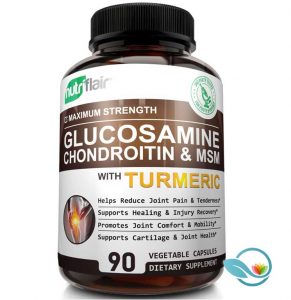 NutriFlair’s Premium Glucosamine Chondroitin Turmeric & MSM with Boswellia Extract supplement claims to reduce joint pain, promote joint comfort and mobility, support cartilage and joint health, and preserve bone health. A bottle of 90 capsules (30 servings) is priced at around $14 on Amazon, making it higher-priced than most other options on this list but in line with the Zenwise and Made In Utah glucosamine supplements above.
NutriFlair’s Premium Glucosamine Chondroitin Turmeric & MSM with Boswellia Extract supplement claims to reduce joint pain, promote joint comfort and mobility, support cartilage and joint health, and preserve bone health. A bottle of 90 capsules (30 servings) is priced at around $14 on Amazon, making it higher-priced than most other options on this list but in line with the Zenwise and Made In Utah glucosamine supplements above.
NutriFlair’s glucosamine supplement contains similar dosages to the two supplements listed above as well: you get 1500mg of glucosamine in each 3 capsule serving along with 150mg of chondroitin, 150mg of turmeric, and 200mg of boswellia, among other ingredients. Altogether, the ingredients add up to 2100mg of joint support formula.
NutriFlair isn’t the most popular or best-selling glucosamine supplement on Amazon. However, it offers similar high-quality formulations to the two supplements listed above.
NutriRise Glucosamine Chondritin Turmeric & MSM
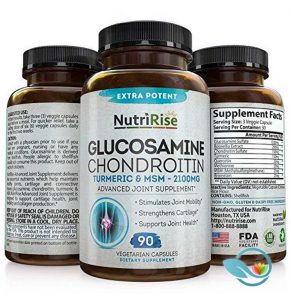 NutriRise’s formula is suspiciously similar to NutriFlair’s formula above. Each 3 capsule serving contains 2100mg of glucosamine, chondroitin, turmeric, and MSM to stimulate joint mobility, strengthen cartilage, and support joint health.
NutriRise’s formula is suspiciously similar to NutriFlair’s formula above. Each 3 capsule serving contains 2100mg of glucosamine, chondroitin, turmeric, and MSM to stimulate joint mobility, strengthen cartilage, and support joint health.
The dosages are virtually identical to NutriFlair’s glucosamine supplement: you get 1500mg of glucosamine, 200mg of boswellia, 150mg of chondroitin, and 150mg of turmeric in each 3 capsule serving, for example.
Pricing is also similarly high: you’ll pay $16 for a bottle containing 30 capsules. However, if you like the idea of combining glucosamine with herbal extracts, turmeric, and other ingredients, then NutriRise’s supplement may be a good choice.
NOW Glucosamine
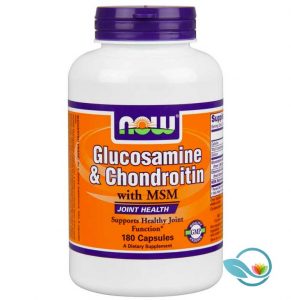 NOW makes dozens of trendy health supplements sold on Amazon and other major retailers. With an average rating of 4.5 stars and 560+ customer reviews, NOW Glucosamine is one of the best-rated glucosamine supplements on Amazon.
NOW makes dozens of trendy health supplements sold on Amazon and other major retailers. With an average rating of 4.5 stars and 560+ customer reviews, NOW Glucosamine is one of the best-rated glucosamine supplements on Amazon.
The formula is priced at around $13 for a 90 capsule (30 serving) bottle. Each serving contains 1500mg of glucosamine, 1200mg of chondroitin, and 300mg of MSM. The dosages and price don’t quite compete with the options at the top of our list in terms of value. However, this is still a great glucosamine joint support supplement at a reasonable price.
Doctor’s Best Glucosamine Chondroitin MSM with OptiMSM
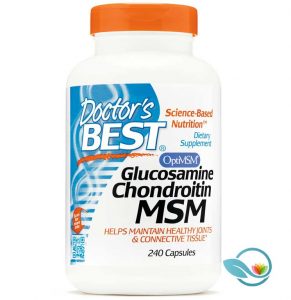 Doctor’s Best, like NOW, makes a wide range of popular supplements on Amazon. If you’re looking for an affordable glucosamine supplement with a surprisingly strong dose, however, then the Doctor’s Best glucosamine supplement quietly delivers.
Doctor’s Best, like NOW, makes a wide range of popular supplements on Amazon. If you’re looking for an affordable glucosamine supplement with a surprisingly strong dose, however, then the Doctor’s Best glucosamine supplement quietly delivers.
Each 240 count (60 serving) package is priced at around $20. Each 4 capsule serving includes 1500mg of glucosamine, 1200mg of chondroitin, and 1000mg of MSM. These are all standard ingredients among glucosamine supplements. However, Doctor’s Best also includes small doses (4% to 8% Daily Value) of chloride, sodium, and potassium.
The main drawback with the Doctor’s Best supplement is that you need to take four capsules per day instead of two or three.
Amazon Brand Solimo Glucosamine Chondroitin Complex with MSM
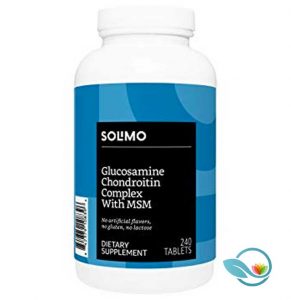 Amazon has its own glucosamine supplement under the Solimo brand. The supplement is one of the most affordable options on this list, priced at $19 for 240 tablets (120 servings). Each 2 tablet serving includes 1500mg of glucosamine, 100mg of boswellia, and 1103mg of chondroitin/MSM.
Amazon has its own glucosamine supplement under the Solimo brand. The supplement is one of the most affordable options on this list, priced at $19 for 240 tablets (120 servings). Each 2 tablet serving includes 1500mg of glucosamine, 100mg of boswellia, and 1103mg of chondroitin/MSM.
If you’re looking for a barebones glucosamine supplement that delivers a high dose of all its ingredients in just two capsules and at a reasonable price, then it’s tough to compete with the Amazon Solimo glucosamine supplement.
BioSchwartz Maximum Strength Glucosamine MSM & Chondroitin
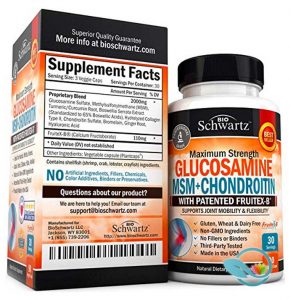 BioSchwartz Maximum Strength Glucosamine MSM & Chondroitin is one of Amazon’s best-selling glucosamine supplements. The formula contains similar ingredients to most other supplements on this list, but it also contains a unique ingredient called FruiteX-B (calcium fructoborate), a proprietary formula that purportedly boosts bioavailability.
BioSchwartz Maximum Strength Glucosamine MSM & Chondroitin is one of Amazon’s best-selling glucosamine supplements. The formula contains similar ingredients to most other supplements on this list, but it also contains a unique ingredient called FruiteX-B (calcium fructoborate), a proprietary formula that purportedly boosts bioavailability.
The main problem with BioSchwartz’s glucosamine supplement is that the company does not disclose its individual ingredient dosages. We know there’s 2000mg of glucosamine, MSM, turmeric, boswellia, and other ingredients, for example, but we don’t get individual breakdowns of each one.
Bluebonnet Glucosamine Chondroitin Plus MSM
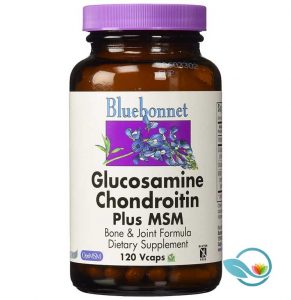 Bluebonnet’s Glucosamine Chondroitin Plus MSM supplement includes 120 capsules (40 servings) in each bottle at a price of around $26, making it one of the highest-priced supplements on our list. Based on that price, you would expect to find premium ingredients inside. However, the supplement seems identical to most other options on this list.
Bluebonnet’s Glucosamine Chondroitin Plus MSM supplement includes 120 capsules (40 servings) in each bottle at a price of around $26, making it one of the highest-priced supplements on our list. Based on that price, you would expect to find premium ingredients inside. However, the supplement seems identical to most other options on this list.
Each 3 capsule serving contains 1000mg of glucosamine, for example, along with 500mg of chondroitin and 500mg of MSM. There’s also 500mg (556% of your Daily Value) of vitamin C – something we don’t see with any other joint supplement.
Nature’s Bounty Glucosamine Chondroitin
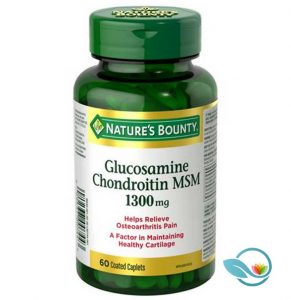 Nature’s Bounty makes a decent glucosamine supplement, although it’s priced slightly higher than most other options on this list for a lower dosage. The supplement is priced at $25 for a 110 capsule (55 serving) bottle, with each serving containing 1100mg of glucosamine along with vitamin C (333% Daily Value), manganese (100% DV), and sodium (1% DV).
Nature’s Bounty makes a decent glucosamine supplement, although it’s priced slightly higher than most other options on this list for a lower dosage. The supplement is priced at $25 for a 110 capsule (55 serving) bottle, with each serving containing 1100mg of glucosamine along with vitamin C (333% Daily Value), manganese (100% DV), and sodium (1% DV).
Overall, the formula claims to support key structural components in cartilage while also boosting collagen formation (thanks to vitamin C).
Vitabreeze Glucosamine Chondroitin MSM & Turmeric
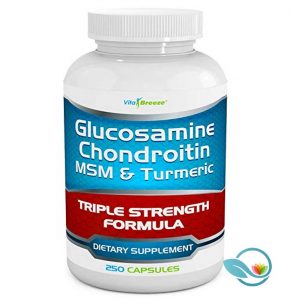 Vitabreeze describes its glucosamine supplement as a “triple strength formula” because it contains three added ingredients beyond glucosamine. Each bottle of the supplement includes 62 servings (250 capsules).
Vitabreeze describes its glucosamine supplement as a “triple strength formula” because it contains three added ingredients beyond glucosamine. Each bottle of the supplement includes 62 servings (250 capsules).
Key ingredients include 1500mg of glucosamine sulfate, 1000mg of chondroitin, 600mg of MSM, 300mg of turmeric, and 84mg of chloride. Those are some of the highest dosages on this list so far – especially the turmeric dose. You also don’t pay as much of a premium for the Vitabreeze formula as you do with other supplements: it’s priced at $29 for 62 servings.
Our Rankings
We’d forgive you for thinking all glucosamine supplements are pretty much the same: that’s what we expected before diving into our rankings. All of the supplements above contain some dosage of glucosamine, but they also contain much different levels of added ingredients, herbal extracts, and other formulas that could support joint health in various ways.
With that in mind, here’s how our editorial team compiled the rankings above:
Dosage: Glucosamine seems to be most effective when used at a dose between 1000mg and 1500mg per day. We focused on supplements that used that dose. We also took the dosage of MSM, chondroitin, turmeric, and other ingredients into account, although the dose of glucosamine was most important.
Other Ingredients: Many formulas above contain just glucosamine and chondroitin. Some formulas add MSM, turmeric, and boswellia to the mix. Others add vitamins and minerals. All of the supplements above contain only proven ingredients. We analyzed each ingredient profile to verify that they used dosages known to support joint health.
Delivery Method: All of the glucosamine supplements listed above are packaged into capsules or tablets. However, some formulas were so packed with binders and fillers that it took 4 capsules to deliver the same dose other supplements delivered in 2 capsules.
Price and Value: There’s no point in buying a glucosamine supplement if it’s $200 more expensive than similar supplements. We took price and value into consideration in all our rankings. We were also careful to display an option for all budgets. The glucosamine supplements above tended to range in price from $5 to $30 for a 30-day serving, so prices varied widely.
Overall, the best-performing supplements in our rankings were supplements that contained a high dose of glucosamine while minimizing extra ingredients.
Who Should Take Glucosamine?

All types of people take glucosamine. However, it’s particularly popular among those with joint pain, arthritis, osteoarthritis, rheumatoid arthritis, previous joint injuries, and similar conditions.
Some people swear by glucosamine’s ability to reduce joint health, improve mobility, and slow down the spread of cartilage damage. Some people even claim that glucosamine can reverse this damage. They take it daily to live a life free of joint pain.
Many people also appreciate that glucosamine can relieve joint pain without the harmful side effects of NSAIDs and other pain relievers. Glucosamine might go to work more slowly, but it’s easier on your system than NSAIDs.
Not everyone who takes glucosamine supplements has arthritis. Some people take glucosamine for old sports injuries or joint injuries, for example. If you have a nagging injury or pain that never fully healed, then glucosamine may be able to help.
Does glucosamine really work? Or is it just an over-hyped joint health ingredient backed by limited science? Keep reading to discover some of the scientific evidence behind glucosamine.
Benefits of Glucosamine

Glucosamine has been extensively studied for its ability to relieve joint pain and reduce inflammation. Glucosamine is simply a chemical combination of an amino acid and a sugar. It’s a complex carbohydrate that appears to specifically reduce joint pain.
The reason we feel joint pain is simple: typically, joint pain is caused by irritation, inflammation, or degeneration of the cartilage surface inside your joints. Glucosamine may reduce these symptoms by enhancing the water retention ability of your cartilage. Your cartilage holds onto more water naturally, helping your joints stay more lubricated.
Researchers also believe that glucosamine could help new cartilage tissue grow within the body. Some research shows that glucosamine increases the synthesis of cartilage tissue, reducing joint pain by helping your body grow new cartilage between your bones.
Science first started analyzing the benefits of glucosamine in the 1980s.
This study published in Pharmatherapeutica in 1981, for example, analyzed the effects of 400mg of glucosamine on 30 patients with osteoarthritis. Patients received glucosamine via intravenous or intramuscular injection for the first week, followed by oral supplements 6 x 250mg capsules per day) for the next two weeks.
After 7 days of glucosamine supplementation, patients treated with glucosamine had improved joint pain and mobility “to a faster and greater extent” than the control group.
Where this study really amazed researchers, however, was in the maintenance phase. After receiving intravenous glucosamine supplementation, participants switched to oral supplements. During the maintenance phase, the control group’s symptom scores reduced almost to the pre-treatment level, while the glucosamine group’s scores actually improved.
Based on the results of this landmark study, researchers recommended that “oral treatment with pure glucosamine sulphate should be considered as basic therapy for the management of primary or secondary degenerative osteoarthritis disorders.”
Of course, this study only involved 30 people. What happens when a group of 212 people are tested? In this study published in The Lancet in 2001, researchers gave half the group a 1500mg glucosamine supplement and the other half a placebo. Subjects were followed for three years, with the progress of their osteoarthritis evaluated by x-rays.
At the conclusion of the three year study, researchers found that the group taking glucosamine had no joint space narrowing, while the control group had significantly decreased joint space.
Based on these results, researchers suggested that glucosamine was effective for slowing down (or even stopping entirely) the progression of osteoarthritis in breaking down the gaps between joints.
Glucosamine appears to work by encouraging cartilage to stay healthy. Glucosamine appears to help your cartilage retain water or synthesize new tissue, for example. This study published in 1998 by a group in Italy reinforced this effect: the group exposed human cartilage tissue from the head of the femur to a solution containing glucosamine. Researchers found that glucosamine increased the synthesis of a protein called proteoglycan. This is the same protein that makes up a significant amount of your cartilage.
What’s even more amazing is that this protein production continued to increase for 12 days after exposure to glucosamine. Based on the results of this study, researchers believe glucosamine’s connection to protein production is one reason it reduces the loss of joint space.
This effect was observed again in a study published in the Annals of Rheumatic Diseases. That placebo-controlled study involved 600 subjects who took either glucosamine or a placebo for two years. At the conclusion of the study, researchers found that the glucosamine group had less joint narrowing than the control group.
Other people take glucosamine supplements to manage pain. Can glucosamine really reduce pain at a similar level to ibuprofen and other NSAIDs?
The paper we just mentioned above found that there was not a statistically significant difference in pain outcomes after patients took glucosamine for two years. The people who received the placebo reported the same amount of pain improvement as those taking the glucosamine supplement – which is strange considering the glucosamine group had reduced the rate of joint narrowing.
Other studies, however, have confirmed the ability of glucosamine to reduce pain. This meta-analysis performed by researchers in Boston analyzed 15 studies on glucosamine and osteoarthritis to determine a link between glucosamine and pain relief.
Researchers found that glucosamine had a proven ability to reduce pain. However, the effects weren’t as statistically significant as some studies claimed due to “quality issues and likely publication bias.” Nevertheless, researchers admitted that “some degree of efficacy [for pain relief] appears probable.”
Another study on the pain relief benefits of glucosamine analyzed the effects of glucosamine at reducing pain from old injuries. The study was published in the British Journal of Sports Medicine in 2003. Participants with prior, regular knee pain received 2000mg of glucosamine supplementation per day or a placebo, then were analyzed over a 12 week period. At the conclusion of the study, researchers found there were significant improvements in knee pain in the glucosamine group compared to the placebo group.
Interestingly, the study also found that the most significant improvements occurred within the first eight weeks of glucosamine supplementation. That means you’ll know within about two months whether or not glucosamine supplements will reduce your injury pain.
While glucosamine may reduce knee pain, it hasn’t proven to be as effective for lower back pain. This study published in the Journal of the American Medical Association in 2010, for example, analyzed the effects of glucosamine on patients with chronic low back pain and degenerative osteoarthritis of the lower back. Patients received 1500mg of glucosamine or a placebo for a one year period.
After one year, both groups reported slight improvements in back pain. However, there were no significant differences between the placebo and glucosamine group regarding low back pain. Based on the results of this study, researchers concluded that glucosamine was not helpful for lower back pain the same way it has been shown effective for knee pain and hip pain.
Overall, numerous studies on glucosamine have demonstrated its effectiveness at treating various aspects of joint pain, arthritis, osteoarthritis, and other conditions. Its pain relief benefits haven’t been observed in all studies, but many people swear by glucosamine’s ability to treat joint pain long-term.
Side Effects of Glucosamine

Glucosamine has been studied extensively since the 1980s. In all studies performed so far, glucosamine has been well-tolerated by participants involved in the above studies.
Few side effects have ever been reported, in fact. Many of the studies listed above have lasted for 2 or 3 years with no side effects reported.
The only side effect we’re aware of is that glucosamine supplements could be harmful to those with shellfish allergies. Glucosamine is derived from marine shells, so those with shellfish allergies should avoid it.
There are also reports that glucosamine could elevate international normalized ratio (INR) in individuals taking blood thinners like warfarin. Some reports also claim that glucosamine could interfere with the effectiveness of chemotherapy.
Recommended Dosage of Glucosamine
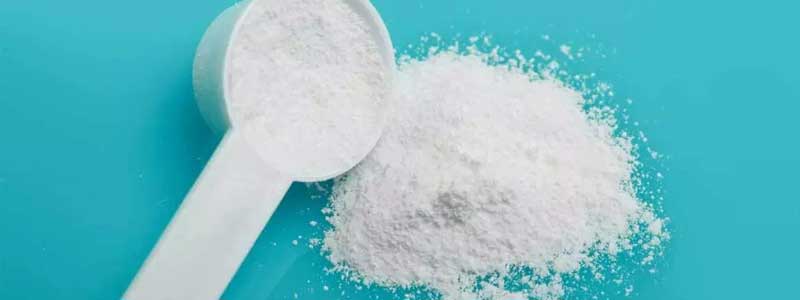
Studies on glucosamine typically use a dose of 500mg to 1500mg per day.
The supplements listed above all match that dose, with most containing 1000mg to 1500mg of glucosamine per day.
Generally, it’s a good idea to follow the dose recommended by the manufacturer on your glucosamine supplement. We also recommend talking to a doctor to verify that glucosamine is the right choice for you.
Some studies show that your body can only absorb so much glucosamine per day, and going beyond a 1500mg dose does not lead to any added benefit.
FAQs About Glucosamine
Q: What is glucosamine?
A: Glucosamine is a combination of a sugar (“glucose”) and an amino acid (“amino”). It’s an amino sugar that is also a precursor to your body’s formation of proteins and lipids (fats). In other words, your body needs glucosamine to produce certain fats.
Q: Where does glucosamine come from?
A: Most of the glucosamine supplements on the market today source their glucosamine from crustacean exoskeletons – the shells of small organisms from the ocean. However, it’s also possible to derive glucosamine by fermenting rains like corn or wheat. Some manufacturers have started producing vegetarian and vegan-friendly glucosamine supplements made from corn or wheat.
Q: Is glucosamine approved as a drug?
A: In the United States, glucosamine is considered a supplement. It is not approved by the Food and Drug Administration for medical use in humans as a drug. As a supplement, glucosamine must be proven safe, although it does not have to be proven effective. In Europe, however, glucosamine is approved as a medical drug and several guidelines recommend using glucosamine to effectively and safely treat osteoarthritis.
Q: Why should I take glucosamine?
A: People take glucosamine for a variety of reasons. Some people take glucosamine to reduce general joint pain. Others use it to manage symptoms of a specific condition – like osteoarthritis. Some people just have a nagging injury or joint problem that never went away.
Q: Is glucosamine safe?
A: Glucosamine has been studied extensively since the 1980s. Some of the studies have lasted 2 or 3 years. In all of these studies, glucosamine has been well-tolerated. Side effects are rare. If you have shellfish allergies, then you may not want to take glucosamine (most commercial formulas are derived from marine exoskeletons).
Q: Is glucosamine vegan or vegetarian?
A: Most glucosamine supplements are not considered vegan or vegetarian because they contain the exoskeletons of marine organisms. However, some glucosamine producers now make corn-derived glucosamine supplements suitable for vegans and vegetarians.
Q: Do glucosamine supplements improve joint health?
A: Studies show that glucosamine can increase protein generation in the cartilage between your joints, reducing the spread of degenerative joint conditions and improving mobility. Based on most research, glucosamine does seem to significantly improve joint health.
Q: Can glucosamine reduce pain?
A: Studies are mixed on the pain relieving properties of glucosamine. Some studies indicate that glucosamine can reduce pain significantly in patients with joint pain and osteoarthritis. Other studies have indicated no difference between glucosamine and a placebo. In the studies mentioned above, glucosamine was proven to be effective for pain relief in hip and knee pain, for example, but ineffective for low back pain relief.
Q: Can I get glucosamine from foods or other sources? Do I have to take glucosamine supplements?
A: Unlike with many other supplements, glucosamine is not found in any foods in a significant amount. Yes, glucosamine occurs naturally, but it’s not feasible to consume enough food to get the equivalent dose used in the studies above. Glucosamine supplements are the only practical way to get an effective dose of the ingredient.
Q: Why do all glucosamine supplements contain MSM?
A: Studies have shown that methylsulfonylmethane (MSM) could enhance the biological efficacy of glucosamine. It helps your body absorb and utilize glucosamine. That’s why it’s often found in glucosamine supplements. However, more studies need to be done on the right dosage or ratio of glucosamine to MSM.
Q: What is glucosamine chondroitin?
A: Some supplements call themselves “glucosamine chondroitin” supplements. In reality, glucosamine and chondroitin are two different ingredients. It’s just a marketing term. However, chondroitin is similar to MSM in that it may enhance the efficacy of glucosamine when used in the right dosage.
Q: How does glucosamine work?
A: We don’t know for sure how glucosamine works. Some studies have shown glucosamine increases the production of certain proteins in the cartilage. Other studies show that it reduces joint shortening, but researchers don’t know how. Ultimately, the precise mechanisms behind glucosamine remain unknown.
Q: How long does it take glucosamine to work?
A: In the studies above, it typically took about 8 weeks for glucosamine to work. At minimum, you should give glucosamine 2 to 3 months to determine whether or not it’s effective for you. One of the studies linked above found that the biggest benefits of glucosamine were seen within two months of beginning supplementation.
Q: How long does glucosamine remain in my system?
A: The half-life of glucosamine is about 15 hours. After you take a full dose of glucosamine, half of it has been eliminated from your body within 15 hours. If you’ve been taking glucosamine regularly, then it may take a few days to eliminate it from your system.
Q: What time of day should I take glucosamine?
A: Glucosamine is long-lasting within your body, so the time of day at which you take the supplement isn’t really important. Typically, the supplements above recommend an equal dose taken three times per day (say, 1500mg split into three doses of 500mg each).
Final Word
Glucosamine is one of the most popular joint health supplements available today. It’s considered a drug in Europe and is recommended as a treatment for osteoporosis. In the United States, however, it’s not considered a drug by the FDA, which is why we see so many glucosamine supplements.
In numerous studies, glucosamine has shown to be effective for treating joint pain, improving joint mobility, and enhancing joint health in various ways. However, its precise mechanisms remain unknown.
Consider trying one of the glucosamine supplements listed above to protect yourself from joint degradation and joint pain.


